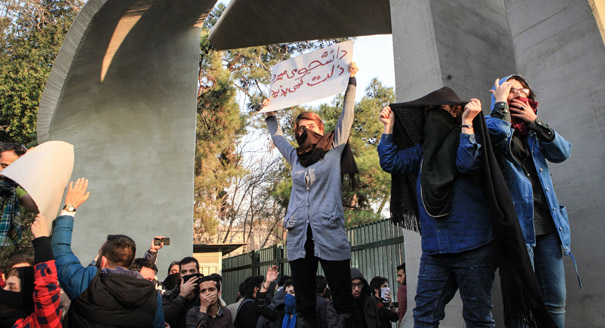The protests that began in Iran at the end of 2017 drew immediate comparisons to the uprisings that consumed the Arab world starting in December 2011.
A week into the Iran protests, I wrote a short article examining some of the lessons for Iran from the scholarship on the Arab uprisings. Two weeks ago, it remained unclear whether the protests would escalate into a genuinely regime threatening wave or whether they would be successfully contained. Today, it appears that the protests have begun to fade in the face of firm state repression and the inherent problems of sustaining mobilization in the absence of strong organizational structures.
This outcome is largely in line with what should have been expected based on what happened in the Arab world. Prior to the Tunisian and Egyptian uprisings, analysts and scholars tended to underpredict revolutionary upheaval based on the long experience of authoritarian stability and regime resilience. After the shocking overthrow of Tunisian president Zine al-Abidine ben Ali and Egyptian president Hosni Mubarak, many analysts went too far in correcting this by overpredicting revolutionary change, and allowed analysis to become clouded by emotional investment in particular actors. But not a single Arab country replicated the Tunisian and Egyptian model of peaceful removal of the president through popular mobilization. It should be no surprise, then, that Iran also did not.
But the bar of regime overthrow is too high when it comes to assessing political change. The Arab uprisings generated a tremendous amount of change in political institutions, identities, and ideas, even where regimes survived. This, not regime overthrow, is where to look in assessing the significance of the Iran protests. What new social movements emerged in this political environment? Which political elites—reformist or conservative—proved most able to exploit the protests in the ongoing, intense intra-elite conflict? How did the experience of largescale protest change the expectations of political possibility?
In other words, Iran today looks more like Tunisia in January 2018 than Tunisia in January 2011. Like Iran, though with less international attention, Tunisia is experiencing intense protests because of economic grievances and frustration over political stagnation and failed promises. The Tunisian protests feature some social movements which have evolved over the last six years, but also many alienated and angry youths in peripheral areas who have lost faith in the system. While they may not overthrow the Tunisian regime, they challenge the core of its claim to legitimacy and structure the environment for all political actors. And, because of the 2011 experience, all actors must take the possibility of revolutionary escalation seriously.
Several other additional comparative lessons from the Arab experience bear mentioning. The Iranian protests garnered disproportionate attention from international actors who saw political advantage in an adversary’s facing political turbulence. The statements in support of the protests by the Trump administration, intended to correct the supposed mistakes of the Obama administration in not speaking out forcefully in 2009, proved unsurprisingly to make little difference on the ground. Supreme Leader Ali Khamenei, predictably, used the statements as evidence in his efforts to accuse the protests of doing the work of external agitators, but he would have done so anyway. Protestors on the ground continued to focus on their grievances rather than on U.S. rhetoric, the regime repressed as it saw fit to ensure its survival, and the protest wave died down within days of the American proclamations. The irrelevance of American rhetoric in recent weeks should, but won’t, put to rest the mythology of 2009, namely that by speaking out Obama would somehow have changed the outcome.
The experience of the Arab uprisings suggests that external actors may attempt to do more than offer rhetorical support to the protests. Direct and indirect interventions by regional actors were a decisive feature in shaping the trajectory of those uprisings. Political interventions by Qatar, Saudi Arabia, and the United Arab Emirates contributed to the polarization and political failures in Tunisia and Egypt. Military support for proxies, as well as direct military intervention, decisively shaped the tragic course of events in Libya and Syria. It is not beyond the realm of the conceivable that Washington or Gulf regimes might explore the idea of providing arms and material support to Iranian opposition movements. The lessons of Libya and Syria suggest that efforts to stand up a proxy insurgency would be disastrous, but others have learned different lessons.
A final issue worth exploring is the lack of diffusion of protests from Iran outward into the Arab world. Back in 2011, the spread of revolutionary momentum from Tunisia and Egypt defied the expectations of many political scientists. Diffusion made more sense from the perspective of a relatively unified Arab public sphere bound by a common identity and shared media. Arabs in the Gulf and the Levant identified with the Tunisian and Egyptian uprisings, reading them through the lens of a common political struggle and appropriating their slogans and tactics within often very different political contexts. Iran’s Green Movement in 2009 had not inspired similar Arab mobilization, and thus far neither have the Iranian protests of the last few weeks. Despite some intriguing efforts by Syrian activists to reach out in support of Iranian protestors, there have been few real signs of Arabs being stimulated to action.
Years of escalating sectarianism and ethnic identity, as well as the absence of a shared public sphere binding Iranians and Arabs into a collective narrative, seem to be an iron firewall against diffusion.






